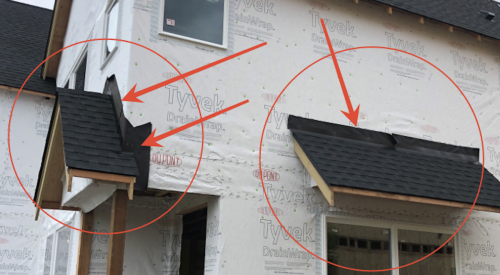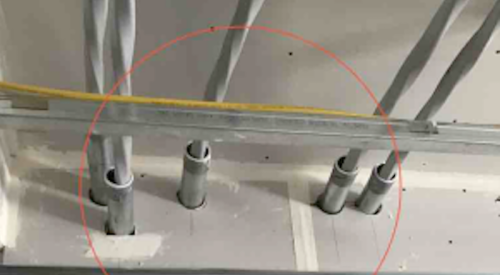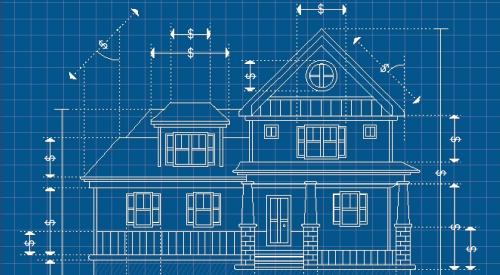Warranty problems can affect margins, sales, employee morale, and a builder’s reputation. However, minimizing warranty expenses can help differentiate your company from the competition. The areas of focus should be design, systems, construction documentation, material selection, proper installation, superintendents and subs, homeowner orientation, warranty defect tracking, and continuous improvement.
1. To minimize warranty expenses, begin with design
Poor design can increase your warranty expenses from the very start. Good design considers constructability and warrantability as much as it does aesthetics. To get it right, involve construction, key trades, and manufacturers’ technical support representatives.
Architectural designs are getting more complex, with simple gable roofs being replaced by combination systems that include hips, valleys, crossed gables, and dormers. While these are all attractive, changes in pitch, plane, and orientation can result in construction defects such as water intrusion if combinations aren’t properly thought through. Give ample consideration to the flow path of precipitation from the roof and avoid any design in which water will directly flow to a wall. Make sure that roof overhangs are adequate and that gutter and downspout drainage paths are clear and direct water away from the foundation.
Elevations that integrate a variety of materials—brick, stone, lap siding, and shake shingles—can also create warranty issues. And the trend toward incorporating more natural light in home design has increased the number of windows, doors, and skylights, adding more details to already complicated architectural designs. Each opening presents an opportunity for water intrusion. Proper flashing and a shingle approach to the drainage plane is paramount.
2. Look for whole-house engineered solutions
Understanding how the house will perform as a whole, integrated unit with its occupants in it is key. This includes structural assemblies—foundation, wall, roof, and floor—and mechanical, plumbing, and electrical systems. Whenever possible, involve third-party experts in the engineering and inspection phases.
For example, rather than having your HVAC contractor size the equipment and duct system, consider using a mechanical engineering firm that specializes in HVAC design, inspection, and testing. Make sure the firm has the proper accreditation; specifically, membership in the American Society of Mechanical Engineers, and in the American Society of Heating, Refrigeration and Air Conditioning Engineers, and is certified by the Air Conditioning Contractors of America. Involvement in organizations like these brings credibility and demonstrates a commitment to the industry and the profession.
3. Review construction documents for clarity
Documents must be clearly written and easy to follow. You can have the best design and a great engineered solution, but if trades can’t follow the construction documents, it’s all for naught. The best way to develop readable construction documents with the appropriate level of detail is to involve the people who will be using them to build the house. Renderings and illustrations are better than the written word. Drawings should have separate detail pages for critical areas. For example, flashing details need to be large enough to easily read and should have their own page in your drawing set. They should clearly illustrate which materials are applied first to ensure an effective drainage plane.
4. Protect yourself in subcontractor, supply, and sales contracts
One way to make sure that trades are properly installing products is to contractually obligate them to do so. A solidly written subcontractor, supply, and sales contract transfers risk to the source of the possible problem. If there’s an issue with the way a manufacturer’s product was installed, it should be the installer’s burden to fix it—all of it. Don’t hold one trade responsible for another trade’s work. For example, if a repair requires removing trim and drywall, the trade that caused it should pay to have it repaired, painted, and cleaned.
Have a clear warranty coverage book that details what’s covered and what’s not. Be specific. For example, if there is a crack in the driveway, specify how wide the crack is and what the crack offset must be before it’s covered. State the methods in which the crack can be repaired; otherwise you leave yourself open to a homeowner who believes you should replace the entire driveway for a surface crack, with no separation or offset. Reference the warranty book in your sales contract and provide homeowners with a copy early in the contracting process so they know what is covered—and what isn’t—before the contract is finalized.
Include specs in the construction document package. Clearly note if you expect that a specific manufacturer’s product will be used. Include the manufacturer name, product SKU number, and a description. Note if alternative material is allowed, but rather than just saying “comparable” product, be specific. Make sure your scope of work includes your expectations. For example: Material should be installed per the manufacturer’s installation instructions. Failure to do so will void the manufacturer’s warranty.
5. Use better materials to create a better home
Cost is always an issue when it comes to the quality of materials used in new-home construction. As far as warranty expenses are concerned, don’t confuse the price of materials with the cost of using them. For example, a pine exterior door jamb may have a lower purchase price, but if you’re in a region that gets a lot of rain, that pine door jamb will wick and rot at the threshold. Better to pay slightly more up front and use a rot-free jamb than pay the cost of replacing a rotten one later.
Do your homework on the materials used in your projects—don’t just blindly relegate responsibility to your trades. Also, don’t confuse brand with quality. While it’s true that some brand names have built their reputation on quality materials, this isn’t always the case.
6. Avoid the most common warranty expense: bad installation
Poorly installed insulation can cause an HVAC system to work harder than it should, creating inefficiencies and resulting in excessive energy consumption. Incorrectly installed shower tile can trigger moisture and mold problems. Improper grading can cause foundation issues. Out-of-place dampers, vents, and ducts can create an uncomfortable home for occupants. Drain pipes with inadequate slope can result in plumbing back-ups and clogged drains. Hardwood that isn’t allowed to acclimate before installation can gap and bow. The list goes on.
In the new normal of subcontractors subcontracting the labor to install your products, there is less focus on training the person who is doing the installation. If you can avoid using subcontractors who subcontract the work, I encourage you to consider it. For training to be effective, you need to work with subs that have actual employees installing the products—subs with low employee turnover. Then invest in those employees. Make sure they receive proper ongoing training. Manufacturers are a great resource for product installation training. After all, it’s in their best interests (and yours) to make sure that their products are correctly installed. As you increase the skill level of the person who actually installs the product, your warranty expenses will go down.
7. Use construction superintendents as a last line of defense against concealed defects
Supers have to walk every house every day. If they don’t catch incorrectly installed or defective products before they’re concealed by drywall, concrete, roofing shingles, etc., it will likely be an expensive warranty issue. Make sure that you provide training for your superintendents. They need to be knowledgeable about proper installation of products in your homes.
8. Use checklists to set standards and ensure consistency
Don’t expect your superintendents to remember everything. Work with them and with your trades to develop checklists at critical construction phases (at the least: framing, mechanical, and final). Checklists will help ensure that specific items are reviewed on every home and that homes are constructed to your standards. If you’re not using checklists to make sure that you’re getting the products and proper installation methods you are paying for, consider implementing them soon.
9. Provide homeowner orientation to ensure proper home maintenance
Give homeowners an orientation manual that addresses everything homeowners need to know and do to maintain their new home. You can also use this as an opportunity to set expectations about what is/is not covered in your warranty program.
10. Track defects to help eliminate root causes
Have a system to track warranty defects at a granular level. Identify warranty issues by the: installing trade, brand of materials, installation date, construction superintendent name, house plan number, and elevation. Review the defect database looking for root causes, then rapidly implement solutions and identify exposure to future warranty problems by tracking homes involving affected trades and material brands.
11. Offer good workmanship to start the homeowner experience on a positive footing
Fit and finish are important. Sloppy cabinet finishes, poor tile fitting, and lack of attention to trim, carpet, and paint can doom you from the start. Your customer satisfaction scores suffer, the homeowner will scrutinize everything else about the home, and you’ve begun the relationship on a sour note.













